Present (and Future?) Mac GPUs:
Vantage and Turbine Benchmarks
under Windows Vista Ultimate
Posted Friday, October 2nd, 2009, by rob-ART morgan, mad scientist
Updated Thursday, October 8th, 2009, with UT III graph that includes Radeon 5870
We gathered up a compelling mix of GPUs -- three of which only run under Windows and that we Mac users might wish were options for OS X. We found two benchmarks that only run under Windows that we thought were instructive.
The first benchmark is FutureMark's Vantage. We ran the feature tests (which are not affected by resolution though we specified "Extreme" settings before running the benchmark.
Feature Test 1: Texture Fill
This test draws frames by filling the screen rectangle with values read from a tiny texture using multiple texture coordinates. The texture coordinates are rotated and scaled between each frame.
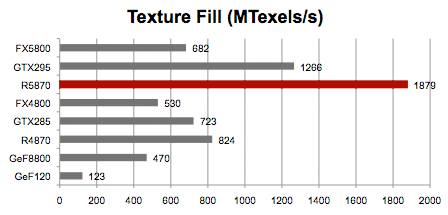
Feature Test 3: Parallax Occlusion Mapping (Complex Pixel Shader)
This test draws frames by rendering a single rectangle (two triangles) on screen, seen from an animated camera position. The pixel shader uses the Parallax Occlusion Mapping technique to simulate complex geometry under the surface of the rectangle. Heavy ray-tracing operations against a huge depth-map determine the actual intersection of the view ray with the geometry. Further ray-tracing determines visibility of that point from multiple animated light sources. Finally, the surface is shaded using the relatively complex Strauss shading model. This test represents a very complex, heavy pixel shader, containing massive amounts of texture reads (ray-tracing) and dynamic flow-control (ray-tracing, looping over multiple lights), as well as traditional lighting calculations (Strauss). All the geometry on screen is rendered on just two triangles, and simulated entirely in the pixel shader.
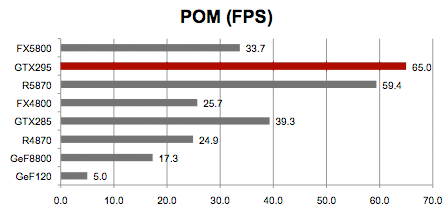
Feature Test 4: GPU Cloth
This test features physical simulation of cloth on the GPU. The simulation is performed as a vertex simulation using a combination of vertex shader and geometry shader stages, with several simulation passes needed for each simulation step. Stream out is used to cycle the cloth vertices from one simulation pass to the next. This test stresses the vertex shading, geometry shading and stream out features of the hardware.
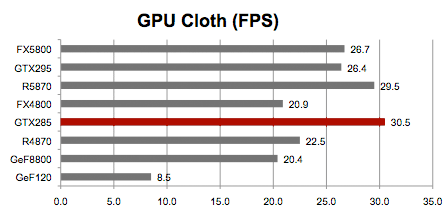
Feature Test 5: GPU Particles
This test features physically simulated particle effects on the GPU. The simulation is performed as a vertex simulation, with each vertex representing a single particle. Stream out is used to cycle the particle vertices from one simulation pass to the next. There are hundreds of thousands of particles in the test, all individually simulated, and colliding with a height map. The particles are rendered by expanding each vertex to a full rectangle in the geometry shader. The test stresses the vertex shading, stream out.
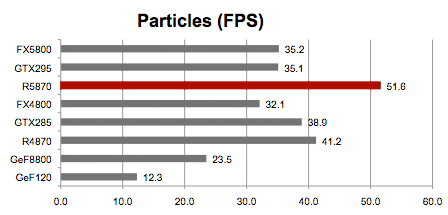
Feature Test 6: Perlin Noise (Math-heavy Pixel Shader)
This test features multiple octaves of Perlin noise evaluated in the pixel shader. Each color channel has its own noise function for added computational load. The Perlin noise function is a standard building block of procedural texturing approaches, and is very math-intensive to compute in a pixel-shader. This feature test emphasizes the arithmetic computing power of the graphics hardware.
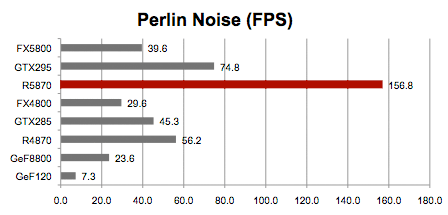
The second benchmark is Redway3D's redSDK 1.5 Turbine Demo benchmark
It uses the most popular visualization modes of CAD apps to illustrate redSDK graphics performances for industrial markets in real-time 2D, 3D, and high quality imaging. Created using redSDK with graphic resources from redmaterials and designed using redviewer, the results are displayed using a rating system. Below are the results while running in Full Screen mode at 2560x1600 on a 30 inch Cinema LCD Display.
TEST 1: Real-Time Viewport rendering which includes...
Unlimited number of lights with multiple pass per pixel shading
Edges display with dynamic contours
Blending hidden edges within the HLR
High quality engine anti-aliasing
Adding geometry lighting over edges, contours, and hidden edges
Geometry picking, selection, and highlight
Real-tim planar glossy reflections
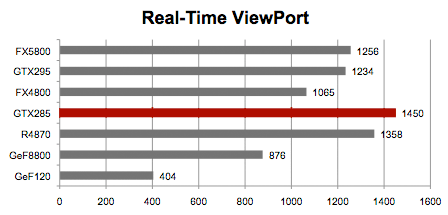
TEST 2: High Quality Real-Time rendering including...
Real-time ray-traced transparencies with advanced per-pixel shaders
Full model dynamic shadows
Multiple viewports and camera compositing
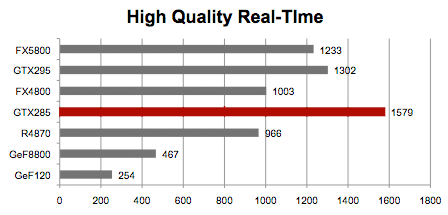
TEST 3: Dynamic Ambient Occlusion including...
Full HDR rendering pipeline with ambient occlusion lighting dome
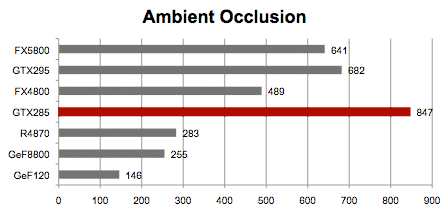
TEST 4: Hybrid Interactive Ray-Tracing technology including...
CPU and GPU accelerated ray-tracer mixed with GPU hardware rendering
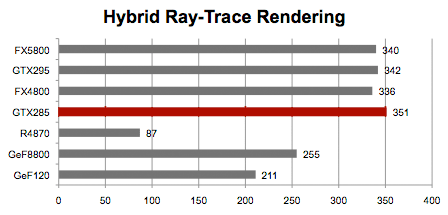
And, finally, three 3D Games (also run under Vista Ultimate).
ID Software ENEMY TERRITORY: QUAKE WARS (ETQW)
For Enemy Territory: Quake Wars (ETQW) we recorded our own netdemo which includes running, shooting, flying, and driving. Settings were at 2560x1600, max quality with 4X multisampling.

EPIC UNREAL TOURNAMENT III
For the UT3 tests, we used the Suspense Flyby. The Flyby emphasizes GPU speed. Though a Botmatch is more like actual game play, the artificial intelligence varies the actions of Bots from run to run, making it impossible to get a repeatable result. Settings were at 2560x1600, max quality. (Note update graph use UT3 patch 5 and now includes Radeon HD 5870.)
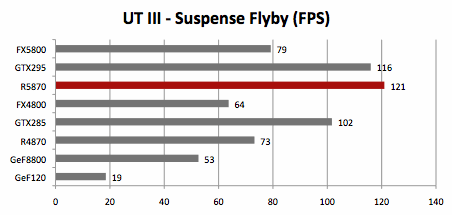
Activision CALL of DUTY 4: Modern Warfare
We ran a timedemo called "mac_pipeline" at 2560x1600 resolution at max quality including 4X Anti-Aliasing, Shadows ON, and Soften Smoke Edges ON.
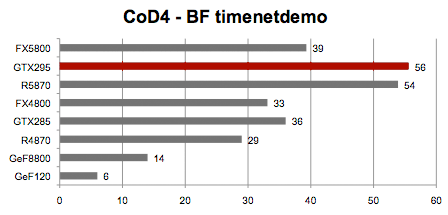
LEGEND OF GRAPHS
RED means fastest
FX5800 = NVIDIA Quadro FX 5800 (4G GDDR3)
GTX295 = NVIDIA GeForce GTX 295 (1.7G GDDR3)
R5870 = ATI/AMD Radeon HD 5870 (1G GDDR5)
FX4800 = NVIDIA Quadro FX 4800 (1.5G GDDR3)
GTX285 = NVIDIA GeForce GTX 285 (1G GDDR3)
R4870 = ATI/AMD Radeon HD 4870 (512M GDDR5)
GeF8800 = NVIDIA GeForce 8800 GT (512M GDDR3)
GeF120 = NVIDIA GeForce GT 120 (512MB GDDR3)
Test "Mule" was the Nehalem Mac Pro 8-core running at 2.93GHz (12G of RAM). Vista Ultimate 64-bit was installed in a Boot Camp partition.
ANALYSIS
1. We expected the workstation GPUs (Quadro FX 4800 and 5800) to do better. They did not post the fastest times in any of the tests including the so-called "Industrial 3D" test (Turbines). According to Wikipedia, the FX 5800 uses the same chipset as the GTX 285, though it does have 4 times as much video memory.
Meanwhile, our search continues for a benchmark or real world app that demonstrations why a Quadro is worth the extra coin. We'll be doing some Maya testing next week in hopes of finally finding something that runs signficantly faster with the Quadro GPUs.
2. A new challenger we were able to include in the Vantage tests and two games was the Radeon HD 5870. It was fastest in two out of five Vantage tests and beat the GeForce GTX 295 in one of the three 3D games (and close behind in the other two. (The 5870 ran Turbine but did not display results.)
For more on the Radeon HD 5870, we recommend careful reading of the Anandtech review.
3. We Mac Pro power users are eager to see OS X compatible GPU technology continue to evolve. I'm hoping we'll see a GeForce GTX 295 "Mac and PC Edition" as well as a Radeon HD 5870 "Mac and PC Edition" in the not-too-distant future.
WHERE TO BY WINDOWS ONLY" GRAPHICS CARDS
Check with NewEgg and Amazon.
WHERE TO BUY MAC PRO GRAPHICS CARDS
Other World Computing has the GeForce GTX 285 with 1 day shipping for $459.
ClubMac has the ATI Radeon HD 4870 Graphics Upgrade Kit for Mac Pro listed for $329. Compare that to the Apple Store USA price of $349.
ClubMac has the NVIDIA Quadro FX 4800 For Mac 1.5GB DDR3 PCIe Graphics Card listed for $1460. Other World Computing also has it listed on their site with same day shipping.
WHERE TO BUY APPLE PRODUCTS
When you purchase products at the Apple Online Store USA, please CLICK THIS LINK or any APPLE BANNERS at the top of our pages. It's a great way to support Bare Feats since we earn a commission on each click-through that results in a sale.